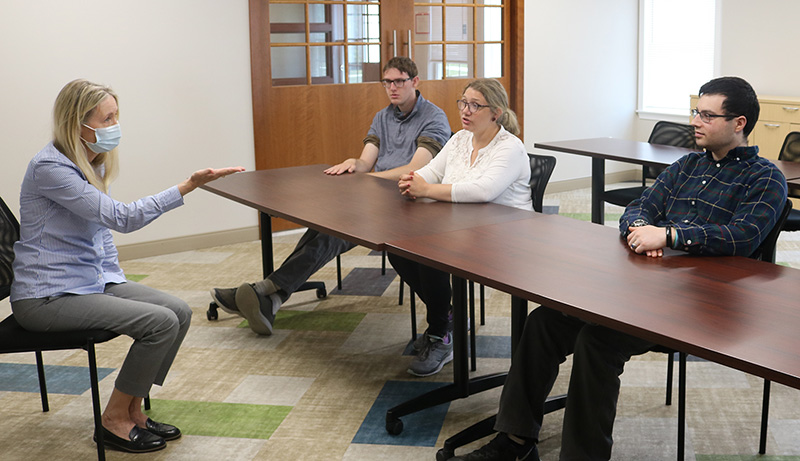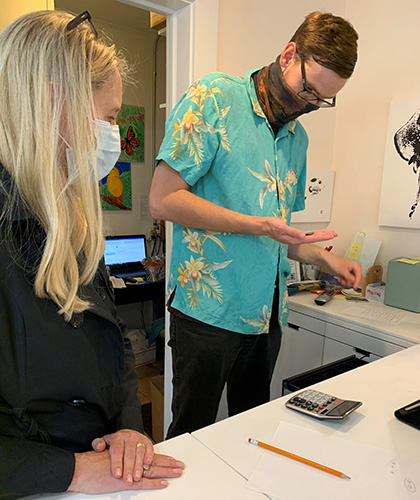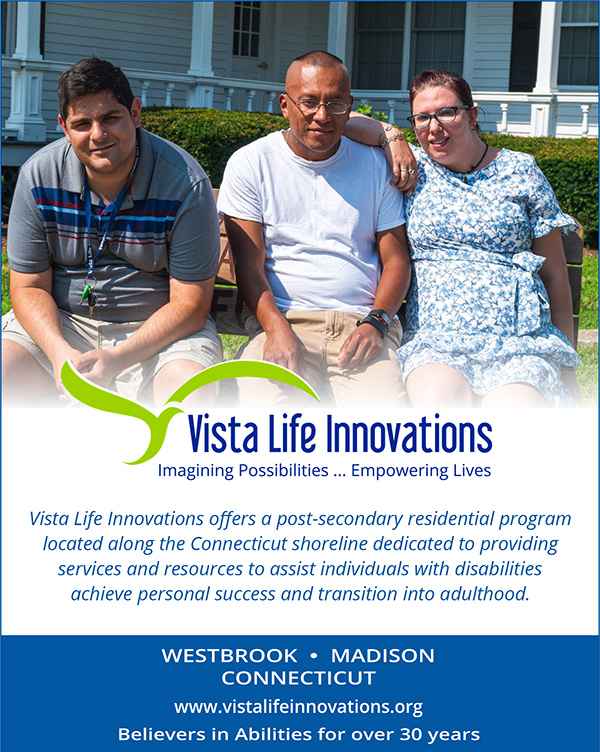Employment can be a source of anxiety for both individuals with disabilities and their families. The rate of unemployment or underemployment for those with autism in the U.S. is particularly high compared to those with other disabilities or the general population (Ohl et al., 2017). Despite the obstacles, organizations like Vista Life Innovations, a nonprofit along the Connecticut shoreline dedicated to assisting individuals with disabilities, have seen those with disabilities like autism find and succeed with paid employment, often staying with the same company for decades if they choose. Vista believes that everyone can be employed in some way and that everyone can reach their full potential. Their strategy for employment success has three steps: build a general foundation of independence, cultivate vocational readiness through job development and training sites, and prepare students to showcase their abilities during the hiring process.

Vista students in Job Development Group discussing how to prepare for a job interview
The first step to becoming ready for employment is building up general independence skills. After all, the traits that make someone an independent, responsible adult are also the foundation for making them a good employee. Post-secondary transition programs like the Discover Program at Vista build these fundamental skills. In the program, students learn three core areas in addition to vocational training: life skills, cognitive and social behavior, and community involvement. Jordan Shamas, Vista’s Discover Program Lead, explains, “It is important to set students up for success. To maintain a job, whether it is paid or volunteer, all adults must ensure they have proper hygiene, look presentable, and respect others, among practicing other positive behaviors independently.” For example, if a student is having difficulty waking up on time for their programmatic group, they most likely would struggle to be on time for work as well. Many skills covered in Discover also give students more potential employment opportunities, like being able to utilize public transportation. To ultimately achieve a higher level of independence, the student and Vista staff collaborate to find strategies to help the student be successful.
Once the student begins to feel comfortable with these core areas, they engage in an employment assessment to see how they do in a vocational setting. This evaluative process is important because even students with a lot of employment experience may respond differently when they are out of their comfort zone in a new environment, sometimes for the better. At Creations, Vista’s retail gift store in downtown Madison, CT, students are able to complete employment assessments. Eugene, a new student with autism in Discover, has been enthusiastic about his employment journey, but was apprehensive to consider positions involving money because of a past negative experience. At Creations, Eugene was able to practice at the cash register and demonstrated his ability to correctly handle money, regaining confidence in his own abilities. This foundation of core skills and low-pressure assessment opportunities give students the confidence to pursue the next phase of their employment journey.
When the student is ready, they move on to the second step on the path to employment by beginning job site training and job development. Students work with job developers in small groups and one-on-one sessions to determine their strengths and potential for growth, talk through how to present themselves and act while at work, and explore areas of interest for their careers. Often, this process involves empowering the student to make their own career choices and expand their thinking. John Brown, one of the Job Developers at Vista, says, “Some students initially struggle to recognize their own passions or strengths, which can be turned into a career path. We ask the students what they want to pursue, so we are supporting their employment journeys rather than making decisions for them.” Job sites are one way for students to see if their interests could turn into a career. Students work with job coaches and their supervisors at job sites to gain employment experience and develop their skills. Vista has numerous partnerships with employers along the Connecticut shoreline to offer a variety of job site opportunities to students, depending on the student’s interests. In addition to Vista’s retail store, Creations, Vista has a second social enterprise designed to offer employment opportunities to students, Ventures Business Services. Ventures is designed to give students the chance to explore a variety of employment opportunities while working with a team specifically trained to engage with individuals with disabilities. Students at their job sites can practice in fulfillment, commercial cleaning, property maintenance or as a receptionist. Because Ventures is designed for those with disabilities, students can experiment with how to set up their environment to achieve success. Beatrice, an individual with disabilities who now works at Ventures, realized, “One of my strengths is being able to focus when I am in a quiet environment. I can get distracted when the environment is loud, so some people I grew up with were surprised that I am good at a job that requires so much concentration!” Ultimately, the student chooses a career direction and moves onto the next step, applying for positions.

Eugene at a Vista’s retail store, Creations, practicing handling money during a job assessment to evaluate his vocational skills
The final stage of gaining employment involves preparing the student for the interview process and cultivating a relationship with the potential employer. “Employment is all about relationships,” explains Brown. “We build relationships with employers so that they are open, comfortable and ready to work with our students. Just as we educate our students about what is expected of them as an employee, we create clear expectations with our employers so that everyone is on the same page.” Students are frequently nervous about the interview or pre-hiring assessment process, but preparation is key to their success. By going over each component of the process and engaging in mock interviews, the student practices extensively before scheduling an official interview or on-site job assessment. This effort becomes worth it when the student enters the process confidently and is able to secure employment, which can be supported by a job coach if beneficial.
For those beginning the journey, it can be hard to imagine finding, keeping, and thriving in a career. Yet, it is possible. Vista’s three steps to employment success are used every day by students in the Discover Program, their college-like transition program. Graduates of the Discover Program often elect to settle along the Connecticut shoreline while receiving select services from Vista’s Engage Program. As of April 1, 2021, nearly 90% of the Engage members wanting paid employment had paid positions. These Engage members work for the nearly 70 different community employer partnerships Vista has along the Connecticut shoreline. It is inspiring to see individuals from Vista building relationships, receiving praise and promotions, becoming financially empowered and giving back to their communities through their employment. Frank, an individual with autism who has worked at his position for three years, is proud that his work involves shipping components used on emergency vehicles. For Frank: “Of course, I like working because of the money I earn, but I also am glad that I am giving back to the community with my work…I’m happy with the success I’ve had, and I hope to accelerate and keep growing in my career as I develop a more sophisticated skill set.” Regardless of where you are on your employment journey, it is never too late to imagine the possibilities.

Becky Lipnick
Please note: The names of the Vista students and members in this article have been changed for privacy reasons. Becky Lipnick is the Communications Lead at Vista Life Innovations. For over 30 years, Vista has supported individuals with disabilities achieve personal success. Learn more at www.VistaLifeInnovations.org or contact Becky at BLipnick@VistaLifeInnovations.org.
References
Ohl, A., Grice Sheff, M., Small, S., Nguyen, J., Paskor, K., & Zanjirian, A. (2017). Predictors of employment status among adults with Autism Spectrum Disorder. Work (Reading, Mass.), 56(2), 345–355. https://doi.org/10.3233/WOR-172492




